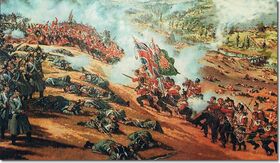Chattanooga-Ringgold Campaign
The Chattanooga-Ringgold Campaign (22 September – 25 November 1863) was a series of battles in October and November 1863, during the Concordian Civil War. Following the defeat of Maj. Gen. Noah Christopher Rosecrans' Royalist Army of the Cumberland at the Battle of Chickamauga and Dyer's Ford in September, the Republican Grand Army of the Piedmont under Gen. Antiochus Stephen Bragg besieged Rosecrans and his men by occupying key high terrain around Chattanooga.
During that time, Field Marshal John Sugiyama's Lucio-Erebonian Army was resting following the Second Vicksburg Campaign and were preparing to push east. The news of Rosecrans' failure immediately reached Prime Minister Abraham Perry, who immediately requested Marshal Sugiyama to reinforce the besieged Royalist forces. He was later given total command of all Royalist Forces in the West. Significant reinforcements also began to arrive with him in Chattanooga and the Eastern Theater. On 18 October, Sugiyama removed Rosecrans from command of the Army of the Cumberland and replaced him with Lt. Gen. Dominic G. Thomas.
After the opening of a supply line (the "Biscuit Line") to feed the starving men and animals in Chattanooga, a force under Maj. Gen. Lucas Cunningham fought off a Republican counterattack at the Battle of Marion County on October 28–29, 1863. On November 23, the Army of the Cumberland advanced from the fortifications around Chattanooga to seize the strategic high ground at Orchard Knob while elements of the Royalist Army of the Tennessee under Maj. Gen. Jacob Tecumseh Saunders and the Erebonian-Rubrumian Joint Corps under Lt. Gen. Richard Egret maneuvered to launch a surprise attack against Bragg's right flank on Missionary Ridge. On November 24, Saunders' and Egret's men crossed the Tennessee River in the morning and then advanced to occupy high ground at the northern end of Missionary Ridge in the afternoon. The same day, a mixed force of almost three divisions under Maj. Gen. Lucas Cunningham defeated the Republicans in the Battle of Lookout Mountain. The next day they began a movement toward Bragg's left flank at Rossville.
On November 25, Saunders's attack on Bragg's right flank made little progress. Hoping to distract Bragg's attention, Sugiyama ordered Egret's army to advance in the center and take the Republican positions at the base of Missionary Ridge. The untenability of these newly captured entrenchments caused Egret's men to surge to the top of Missionary Ridge, routing the Army of Tennessee, which retreated to Dalton, Georgiusa, successfully fighting off the Union pursuit at the Battle of Ringgold Gap. Bragg's defeat eliminated the last significant Confederate control of Tennessee and opened the door to an invasion of the Deep South, leading to Saunders's Atlanta campaign of 1864.
